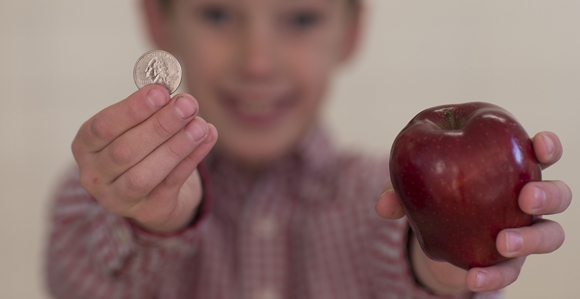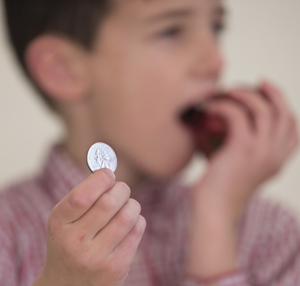BYU Study: Pay Kids to Eat Healthy Foods with School Lunch
Contributed By Ryan Morgenegg, Church News staff writer

A BYU study showed that offering small rewards to children who made healthy lunch choices increased the fruit and vegetable consumption by 80 percent, and the amount of wasted food declined by 33 percent.
“I think that an incentive works best when it helps children form a taste for something or develop a skill.” —Joe Price, BYU economics professor
Related Links
PROVO, UTAH
A new federal rule has prompted the public schools in the United States to serve an extra $5.4 million worth of fruits and vegetables each day. The problem is that the nation’s children throw about $3.8 million of that in the garbage each day.
Researchers from Brigham Young University and Cornell University at Ithaca, New York, observed three schools adjusting to new school lunch standards that require a serving of fruits or vegetables on every student’s tray—whether the child intends to eat it or not. A report published in the December 2013 issue of Public Health Nutrition stated that students discarded 70 percent of the extra fruits and vegetables.
“The best approaches to encouraging a good behavior in children is to find small approaches that nudge children in the right direction,” said BYU economics professor Joe Price, who received his PhD from Cornell. “The guidelines that require children to put fruits and vegetables on their trays are a bit more than a nudge. I think that children might not always react in a positive way when they are being forced to do something.”
Dr. Price then conducted a second study that measured a unique variable. Strange as it sounds, directly paying students to eat a fruit or vegetable is less expensive and gets better results.
With Cornell’s David Just, Dr. Price’s second study measured the effect of small rewards in the lunchroom. The weeklong experiments took on different twists in the 15 different schools they used in the study—some could earn a nickel, others a quarter, and others a raffle ticket for a larger prize.
Regardless of the reward amount, the results were generally the same. As the scholars report in the Journal of Human Resources, offering small rewards increased the fruit and vegetable consumption by 80 percent. And the amount of wasted food declined by 33 percent.
Dr. Price said, “Parents would love for their children to be internally motivated to do the right thing. We tell ourselves that we shouldn’t have to bribe kids to do something that is good for them. However, some habits take a little bit of time to form, and incentives can help move children onto a good path. I think that an incentive works best when it helps children form a taste for something or develop a skill.”

A BYU study considers the benefits of paying children to eat more fruits and vegetables that are added to their school lunch trays. Photo by Mark A. Philbrick, BYU.
The case against using bribes in parenting is perhaps best articulated in Alfie Kohn’s 1999 book, Punished by Rewards. In many scenarios, the use of rewards can crush internal motivation. With healthful eating, for example, some fear that prizes will prevent children from developing their own motivation to eat things that are good for them. Another danger, known as a boomerang effect, is the possibility that some children would eat fewer fruits and vegetables when the rewards disappeared.
That’s why Dr. Price and Dr. Just measured fruit and vegetable consumption before and after the weeklong experiments. When the week of prizes ended, students went back to the same level of fruit and vegetable consumption as before—no lasting improvement, but no boomerang effect either.
Now the researchers are studying whether extending the experiments over three to five weeks might yield lasting change. So far things look promising.
“We learned that even rewards as small as a nickel produce a positive change in children,” Dr. Price said. “We learned that using special veggie tokens are better than using money because you can make sure that the children don’t spend the tokens on candy, and it provides a tangible reminder of why they got the reward.”
The first study documenting the impact of the new rule was published in the December 2013 issue of Public Health Nutrition. The second study is titled “Using Incentives to Encourage Healthy Eating in Children” and is available to subscribers of the Journal of Human Resources. An earlier version of the paper is available at Dr. Price’s website: byuresearch.org/home/downloads/justandprice2011.pdf
